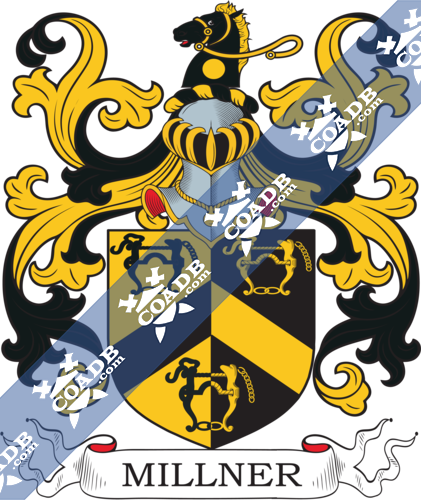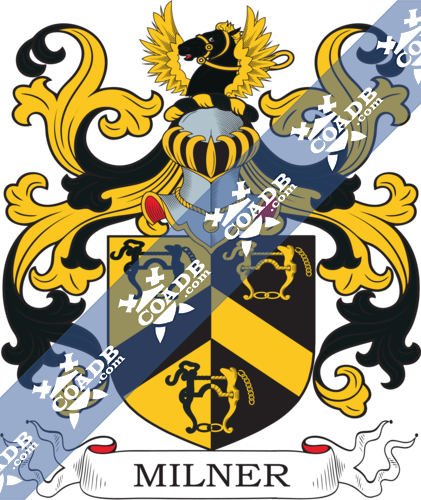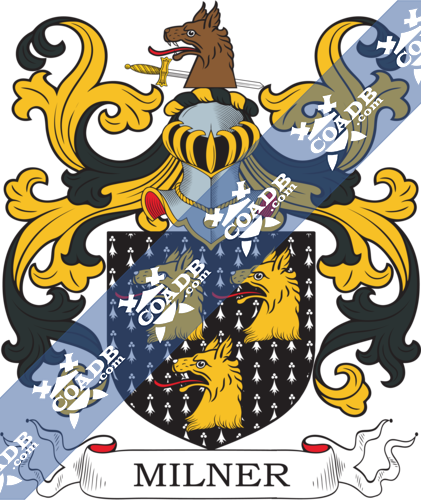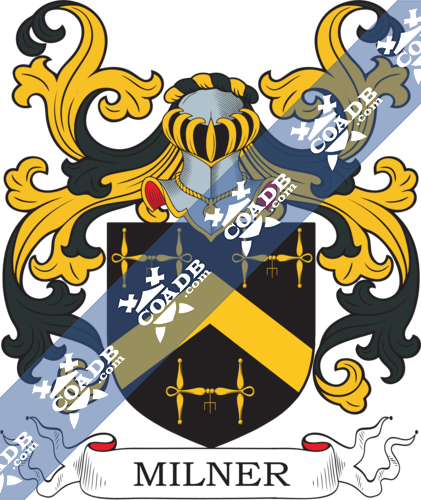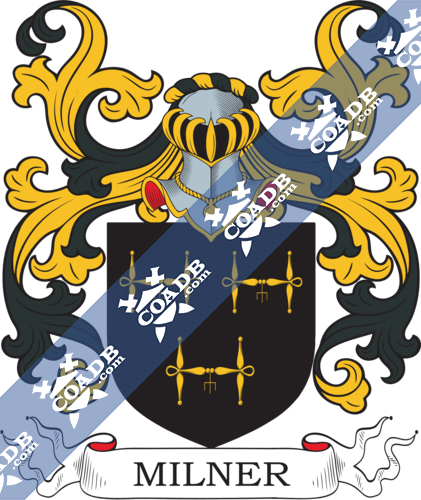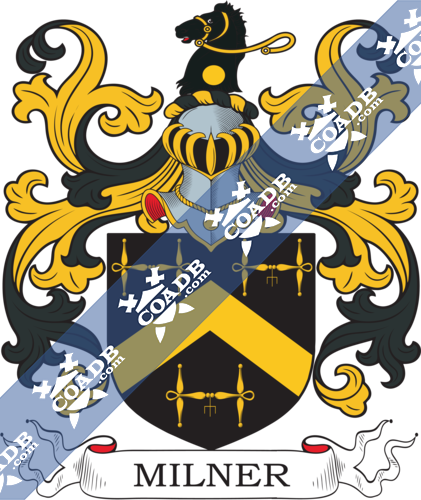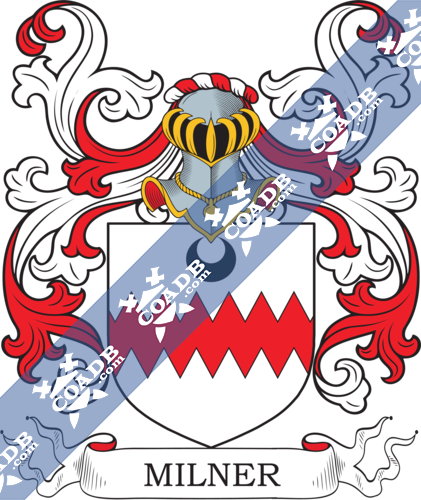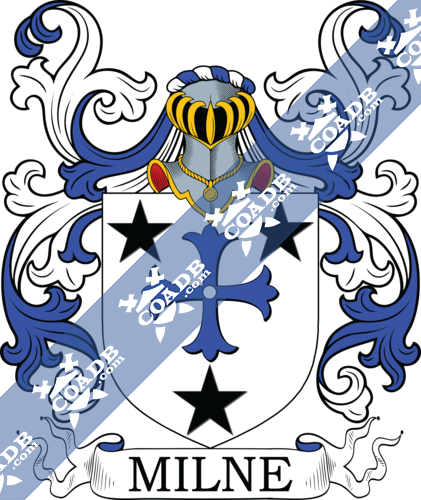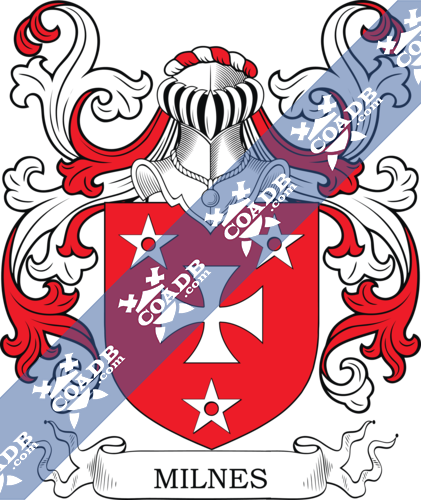Milner Family Crest, Coat of Arms and Name History
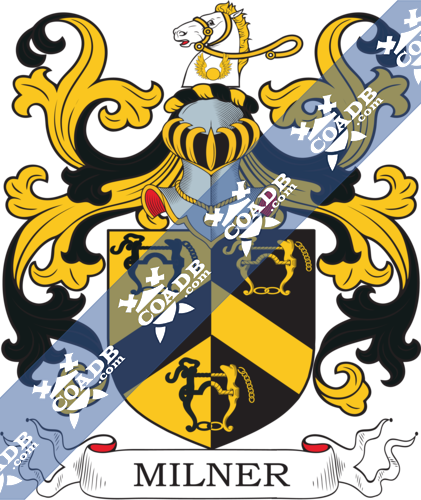
Milner Coat of Arms Gallery
Don’t know which Coat of Arms is yours?
We can do a genealogical research. Find out the exact history of your family!
Learn MoreMILNER
Historically, surnames have various sources of origins. In the case of the name Milner, it is Anglo-Saxon in origin. Derived from the medieval English “mille” or “milne”, which translates to modern English as mill, both come from the ancient English “mylen” which comes from “molina” a variation of “molere” which means “to grind”. In this context, this would also classify the name as occupational. Surnames were often created by using an identifying factor about a person such as; their occupation, a familiar geographical location or a topographical landmark found near the individuals home or birthplace. Use of one of their parent’s names to create a patriarchal or matriarchal surname, or a defining physical trait were among other sources used for surnames. There was almost a limitless source from which they could be formed.
The use of surnames; however, did not become a common practice among the general population until the mid-sixteenth century. Until this time, surnames were generally reserved solely for the noble class. The use of surnames were found to serve a practical purposes, aside from making the distinction between people with like given names easier, it also allowed governments to more effectively track people for census, tax and immigration purposes.
The task of record keeping was primarily under the jurisdiction of the Church, local priories, and the government. This was due in large part to the fact that literacy was a skill usually found only among the nobles, the clergy, and government officials and scribes. Even so, there often existed multiple variations of names which may be attributed to a number of factors; the origins of the surname, the lack of guidelines which existed for spelling, and the fact that many scribes who were charged with record keeping spelled phonetically, among other things. One of the earliest records of anyone bearing the surname or any variation of its spelling is that of John le Mulnare which appears in the Worcester tax rolls dated 1275. These tax rolls were a series of census and tax records kept by the English Treasury by order of King Edward I, with the oldest dating back seven hundred years to the 12th century. They hold the distinction of being the oldest consecutive set of records detailing English governance in the United Kingdom. Some other early variations of the name include; Milner; Millner; Millnor; and Milnor among others.
With the discovery of America and the addition to the British Commonwealth of countries such as Canada, Australia, and New Zealand, it was not long before people began to immigrate to these outlying areas. The use of surnames made tracking of immigrants easier. Some of the first recorded
immigrants to America bearing the surname were Robert Milner who landed and settled in Virginia in 1623. John Milner was one of the early settlers to Canada, landing and settling in Prince Edward Island in 1817. Amelia Milner was an earlier settler to Australia, landing in Adelaide in 1839. Richard and Sarah Milner and their children, George, Rosanna, and Jane, were some of the early settlers to New Zealand, landing and settling in Wellington in 1840.
Worldwide, the highest concentration of people with the surname Milner are found in the United Kingdom, Australia, New Zealand , Canada, and Ireland. By state, the largest percentile of those with the surname Milner live in Georgia, Indiana, Louisiana, Nebraska, New Mexico, and Texas.
There are many persons of note who bear this surname, such as English born statesman and colonial administrator, Alfred Milner, 1st Viscount Milner. He is also considered a key figure within the British Empire in regards to the events leading up to and following the Anglo-Boer War.
Milner served under three monarchs, Queen Victoria, King Edward VII, and King George V in various offices such as; Governor of the Cape Colony and High Commissioner for Southern Africa, Administrator of and 1st Governor of the Transvaal and the Orange River Colony, Secretary of State for War, and Secretary of State for the Colonies.
In recognition of his service, Milner was appointed Companion of the Order of Bath in 1894. The following year he was raised to Knight Commander of the Order of Bath. In 1987, Milner was appointed Knight Grand Cross of the Order of St. Micheal and St. George. He was appointed Knight Grand Cross of the Order of Bath as part of the New Year’s honours list of 1901. In 1921, he was appointed Knight of the Order of the Garter. Milner was created The Right Honorable, 1st Viscount Milner in 1902. With his passing, in 1925 the Viscountcy became extinct.
Blazons & Genealogy Notes
1) (Nun-Appleton, co. York). Per pale or and sa. a chev. betw. three bits counterchanged. Crest—A horse’s head sa. crined and bridled or, charged on the neck with a bezant.
2) (Nun-Appleton Hall, co. York, bart.). Motto—Addit frena feris. Per pale or and sa. a chev. betw. three horses’ bits counterchanged. Crest—A horse’s head couped ar. bridled and maned or, charged on the neck with a bezant betw. two wings gold.
3) (confirmed June, 1772). Same Arms. Crest—A horse’s head sa. bridled or, betw. two wings elevated of the last.
4) (cos. Cornwall and York; granted by Camden). Erm. three wolves’ heads ppr. couped gu. Crest—A wolf’s head ppr. couped gu. pierced through the neck with a broken sword, the point in front of the neck and the wound guttée de sang, pommel or.
5) (Lylliston Green, co. Middlesex; John Milner, of Lincoln’s Inn, son of John Milner, Esq., of Gray’s Inn, and grandson of Richard Milner, all of Lylliston. Visit. Midd. 1663). Ermines three wolves’ heads erased or. Crest—A wolf’s head pierced through with a sword all ppr.
6) (co. Lincoln). Sa. a chev. betw. three snaffle-bits or.
7) (Pudsey, co. York). Sa. three snaffle-bits or.
8) (co. York). Sa. a chev. betw. three snaffle-bits or. Crest—A horse’s head erased sa. bridled or, charged on the neck with a bezant.
9) Quarterly, 1st and 4th, ar. three lozenges conjoined in fesse sa. each charged with a bezant, for Milner, 2nd and 3rd, gu. three catharine wheels ar., for Wheeler Crests—1st, Milner: A greyhound courant sa. collared and ringed or; 2nd, Wheeler: A lion’s head couped ar. charged on the breast with a catherine wheel gu.
10) (co. Nottingham). Ar. a fesse dancettée gu. in chief a crescent sa.

